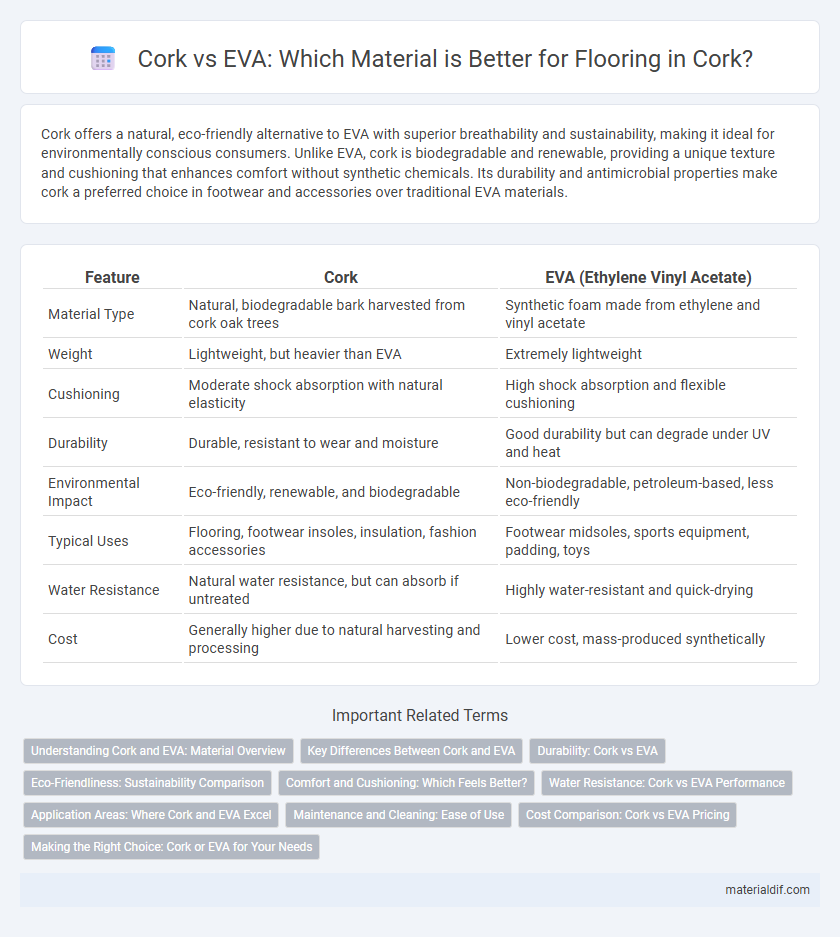Cork offers a natural, eco-friendly alternative to EVA with superior breathability and sustainability, making it ideal for environmentally conscious consumers. Unlike EVA, cork is biodegradable and renewable, providing a unique texture and cushioning that enhances comfort without synthetic chemicals. Its durability and antimicrobial properties make cork a preferred choice in footwear and accessories over traditional EVA materials.
Table of Comparison
| Feature | Cork | EVA (Ethylene Vinyl Acetate) |
|---|---|---|
| Material Type | Natural, biodegradable bark harvested from cork oak trees | Synthetic foam made from ethylene and vinyl acetate |
| Weight | Lightweight, but heavier than EVA | Extremely lightweight |
| Cushioning | Moderate shock absorption with natural elasticity | High shock absorption and flexible cushioning |
| Durability | Durable, resistant to wear and moisture | Good durability but can degrade under UV and heat |
| Environmental Impact | Eco-friendly, renewable, and biodegradable | Non-biodegradable, petroleum-based, less eco-friendly |
| Typical Uses | Flooring, footwear insoles, insulation, fashion accessories | Footwear midsoles, sports equipment, padding, toys |
| Water Resistance | Natural water resistance, but can absorb if untreated | Highly water-resistant and quick-drying |
| Cost | Generally higher due to natural harvesting and processing | Lower cost, mass-produced synthetically |
Understanding Cork and EVA: Material Overview
Cork is a natural, renewable material harvested from the bark of cork oak trees, prized for its lightweight, buoyant, and insulating properties. EVA (ethylene-vinyl acetate) is a synthetic polymer known for its flexible, shock-absorbing, and durable characteristics, commonly used in footwear and sports equipment. Understanding the differences between cork's eco-friendly, breathable qualities and EVA's resilient, cushioning performance helps in selecting the optimal material for sustainable and functional applications.
Key Differences Between Cork and EVA
Cork is a natural, renewable material harvested from the bark of cork oak trees, known for its eco-friendly properties and unique cellular structure that provides excellent cushioning and breathability. EVA (ethylene-vinyl acetate), on the other hand, is a synthetic foam compound prized for its lightweight, flexible, and durable characteristics, often used in footwear midsoles and sports equipment. Key differences include cork's biodegradability and sustainability versus EVA's superior shock absorption and resistance to water and chemical damage.
Durability: Cork vs EVA
Cork exhibits superior durability compared to EVA, especially under conditions of repeated compression and wear. Its natural cellular structure allows it to retain shape and resilience over time, resisting cracking and deformation that EVA foam often experiences. EVA tends to break down faster under heavy use, making cork a preferred choice for long-lasting applications.
Eco-Friendliness: Sustainability Comparison
Cork is a highly sustainable material due to its natural, renewable harvesting process from cork oak trees without harming them, making it biodegradable and carbon-neutral. Ethylene-vinyl acetate (EVA), while lightweight and durable, is a synthetic polymer derived from petroleum, contributing to environmental pollution and non-biodegradability. Cork's eco-friendliness surpasses EVA's, emphasizing renewable sourcing, lower carbon footprint, and full recyclability, crucial factors in sustainable material choices.
Comfort and Cushioning: Which Feels Better?
Cork provides natural shock absorption and molds to the foot over time, enhancing personalized comfort and cushioning. EVA (Ethylene Vinyl Acetate) offers lightweight, responsive cushioning that maintains its shape and provides consistent shock absorption. Comfort preference often depends on whether users prioritize adaptive support from cork or the durable, springy cushioning of EVA.
Water Resistance: Cork vs EVA Performance
Cork offers natural water resistance due to its cellular structure, which repels moisture and prevents water absorption, making it ideal for damp conditions. EVA (Ethylene Vinyl Acetate), a synthetic foam, provides superior water resistance by being fully waterproof and quick-drying. While cork excels in breathability and eco-friendliness, EVA's impermeability ensures better performance in consistently wet environments.
Application Areas: Where Cork and EVA Excel
Cork excels in applications requiring natural insulation and environmental sustainability, such as flooring, wall panels, and thermal insulation due to its renewable, biodegradable properties and excellent sound absorption. EVA (ethylene-vinyl acetate) is preferred in sports equipment, footwear, and packaging for its lightweight, flexible, and shock-absorbing characteristics. Both materials serve unique industries where cork's eco-friendliness and EVA's durability provide significant advantages.
Maintenance and Cleaning: Ease of Use
Cork flooring offers superior ease of maintenance compared to EVA foam, requiring only regular sweeping and occasional damp mopping to keep it clean and in good condition. Its natural antimicrobial properties reduce dust and allergens, making cleaning less frequent and more efficient than EVA, which can trap dirt in its textured surface. Cork's durability and resistance to stains ensure longevity with minimal effort, whereas EVA foam may degrade faster and require more intensive cleaning to maintain appearance.
Cost Comparison: Cork vs EVA Pricing
Cork is generally more expensive than EVA due to its natural harvesting process and sustainability benefits, with prices averaging between $8 and $15 per square foot compared to EVA's $3 to $7. The durability and eco-friendly properties of cork justify its higher cost in flooring and insulation applications. EVA, being a synthetic foam, offers a budget-friendly alternative but lacks the environmental advantages of cork.
Making the Right Choice: Cork or EVA for Your Needs
Choosing between Cork and EVA depends on specific needs such as durability, comfort, and environmental impact. Cork offers natural sustainability, excellent cushioning, and breathability, making it ideal for eco-conscious users seeking comfort. EVA, on the other hand, provides lightweight resilience and superior shock absorption, preferred in high-performance footwear and active lifestyles.
Cork vs EVA Infographic

 materialdif.com
materialdif.com